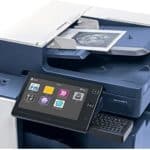Lease Printer for Small Business: The Smart Choice for Budget and Efficiency
Lease Printer for Small Business
Ever feel like your small business is restrict to its printer? For a small business, the upfront cost of a high-quality printer can be a real burden. Enter printer leasing, a financing option that allows you to acquire the printing power you need without breaking the bank.
Leasing a printer offers a multitude of advantages for small businesses. Monthly payments spread the cost out over time, making it easier to manage your cash flow. You’ll also gain access to newer technology, ensuring your printing capabilities stay sharp.
Managed Print Services (MPS), often bundled with leases, can further streamline your printing operations, minimizing downtime and maximizing productivity. We’ll explore these benefits and more in detail throughout this article.

Understanding Printer Leasing for Small Businesses
What is Printer Leasing?
Printer leasing is a financing arrangement where a small business acquires a printer from a lessor for a predetermined lease term. In exchange for a fixed monthly payment, the business gains full use of the printer throughout the lease period. At the end of the term, there are typically options to purchase the printer at a depreciated value, return it, or upgrade to a newer model.
Leasing a printer is a relatively straightforward process. You’ll first identify a reputable leasing company that caters to small businesses. They’ll work with you to assess your printing needs and recommend suitable printers. Once you’ve selected a printer and negotiated the lease terms, the lessor will install the printer and provide any necessary training for your staff.
Benefits of Leasing a Printer for Small Businesses
There are several compelling reasons why printer leasing can be a smart choice for small businesses. First and foremost, it offers a significant advantage in terms of cost-effectiveness. Unlike purchasing a printer outright, which requires a large upfront investment, leasing allows you to spread the cost out over manageable monthly payments. This improved cash flow flexibility can be a game-changer for small businesses, allowing you to invest in other areas critical for growth.
Managed Print Services (MPS) can be another valuable perk associated with printer leasing. MPS bundles your lease payments with toner cartridges, routine maintenance, and on-demand repairs. This comprehensive approach can significantly reduce your printing costs in the long run and minimize downtime associated with printer malfunctions.
Finally, leasing offers a level of flexibility that traditional printer purchases simply can’t match. Lease terms are typically shorter than the lifespan of a printer, allowing you to easily upgrade to a more powerful model as your business grows and your printing needs evolve.
Drawbacks of Leasing a Printer for Small Businesses
While printer leasing boasts numerous advantages, it’s essential to acknowledge some potential drawbacks. One key consideration is the lack of ownership. At the end of the lease term, the printer remains the property of the lessor. This can be a disadvantage if you prefer to own your equipment outright.
There’s also the possibility of long-term costs. Depending on the lease terms and your printing volume, the total cost of leasing a printer over the entire lease period could exceed the purchase price of the same model. It’s crucial to carefully compare lease terms and factor in your printing needs to ensure leasing is the most cost-effective option for your business.
Early termination of a printer lease can also incur fees. Leasing contracts typically lock you in for a set period. If you need to terminate the lease early, you might be responsible for additional charges.
Choosing the Right Leased Printer for Your Small Business
Selecting the perfect leased printer for your small business isn’t a one-size-fits-all proposition. Several factors come into play to ensure you end up with a printing workhorse that seamlessly integrates with your workflow and keeps your cash flow healthy. Let’s delve into the key considerations you should make when leasing a printer.

Factors to Consider When Choosing a Leased Printer
Print Volume: Monochrome printing might suffice if your needs are primarily text-based documents. However, if you require vibrant marketing materials or product brochures, a color printer is a must. Additionally, consider your average monthly print volume. High-volume printing demands a robust printer capable of handling the workload without breaking a sweat.
Functionality: Laser printers excel in high-volume printing environments, delivering crisp text and sharp graphics at impressive speeds. Inkjet printers, while offering excellent color quality at a lower upfront cost, might not be ideal for heavy-duty printing due to higher toner replacement costs.
Multifunctionality (MFPs): Consider a multifunction printer (MFP) if you require a space-saving solution that goes beyond printing. These versatile machines can scan, copy, and fax documents, streamlining your workflow and eliminating the need for separate devices.
Connectivity Options: Wired connections offer a stable and secure printing experience, perfect for network printing in an office setting. For added flexibility, consider a printer with wireless printing capabilities, allowing for mobile printing from laptops and smartphones. Ensure the printer is compatible with your existing network infrastructure.
Security Features: Data breaches can be a nightmare for any business. Look for printers with robust security features like data encryption, user authentication, and secure printing options that require a PIN code to release print jobs.
Types of Printers Available for Lease
Laser Printers: These workhorses are ideal for high-volume printing, offering exceptional speed, sharp text quality, and toner efficiency. The initial cost can be higher than inkjet printers, but lower operating costs make them a cost-effective choice for businesses with frequent printing needs.
Inkjet Printers: A budget-friendly option for occasional printing or vibrant color graphics. However, inkjet printers generally have slower printing speeds and higher toner replacement costs compared to laser printers.
Multifunction Printers (MFPs): These space-saving marvels combine printing, scanning, copying, and sometimes even faxing capabilities into one convenient machine. MFPs are a perfect fit for small businesses that need a versatile document management solution.
Finding a Reputable Leasing Provider
Leasing a printer is an investment, so choosing the right leasing company is crucial. Here are some tips:
- Research potential lessors: Compare pricing and service offerings from multiple companies.
- Experience matters: Look for lessors with a proven track record of serving small businesses.
- Read customer reviews: Reviews from other small businesses can offer valuable insights into the lessor’s customer service and responsiveness.
Leasing a printer can be a cost-effective and hassle-free way to acquire the printing power your small business needs. By carefully considering your printing needs and choosing the right equipment and leasing partner, you can ensure your business stays productive and keeps its cash flow healthy.
The Leasing Process: A Step-by-Step Guide
Now that you’ve identified your printing needs and chosen the ideal leased printer, it’s time to navigate the printer and copier lease process. Here’s a breakdown of the key steps involved:
Step 1: Assess Your Printing Needs
This initial step involves taking a deep dive into your small business’s printing habits. Consider factors like:
- Print volume: How many pages do you typically print per month?
- Color vs. monochrome: Do you primarily need black and white printing, or are color documents essential?
- Functionality: Do you require basic printing, or would scanning, copying, and faxing capabilities be beneficial?
- Connectivity: Will the printer be used in a wired office network, or is wireless printing a necessity?
By carefully considering these questions, you’ll be well-equipped to choose a lease option that perfectly aligns with your business’s specific needs.
Step 2: Research and Compare Lease Options
Once you understand your printing requirements, it’s time to research potential leasing companies. Here are some helpful tips:
- Gather quotes: Request quotes from several reputable leasing companies.
- Compare pricing: Pay close attention to the monthly lease payment, any additional fees (toner, service calls), and the total cost over the lease term.
- Review lease terms: Carefully examine the lease agreement, including the length of the lease, included services (installation, training), and early termination penalties.
Step 3: Negotiate the Lease Agreement
Don’t be afraid to negotiate! Once you’ve identified a leasing company with a competitive offer, review the lease agreement and discuss any potential adjustments. You might be able to negotiate a lower monthly payment, a longer warranty period, or additional toner cartridges included in the lease.
Step 4: Installation and Training
After finalizing the lease agreement, the leasing company will deliver and install your new printer. They’ll also provide your team with comprehensive training on how to operate and maintain the printer.
Step 5: Ongoing Service and Support
A reputable leasing company will offer ongoing service and support throughout the lease term. This might include:
- Technical support: Access to a team of experts to troubleshoot any printer issues that arise.
- Toner replacement: Automatic toner replenishment ensures you never run out of ink at a critical moment.
- Preventative maintenance: Regular maintenance helps to keep your printer running smoothly and minimizes downtime.
By following these steps and choosing a reliable leasing company, you can ensure a smooth and hassle-free printer leasing experience for your small business.
Managed Print Services (MPS) with Printer Leasing
Imagine a world where your office printer practically runs itself! That’s the magic of Managed Print Services (MPS), a service bundle often offered alongside printer leases. Think of it as a one-stop shop for all your printing needs. In addition to the printer itself, MPS encompasses a range of services designed to streamline your printing operations and keep your printing costs in check.

What is Managed Print Services (MPS)?
Managed Print Services is a comprehensive solution that goes beyond simply leasing a printer. It typically includes:
- Toner management: The MPS provider automatically monitors your toner levels and replenishes cartridges before you run out, ensuring uninterrupted printing.
- Preventative maintenance: Regular printer maintenance helps to prevent costly breakdowns and keeps your printing operation running smoothly.
- Technical support: A dedicated team of experts is readily available to troubleshoot any printer issues that may arise.
- Cost-per-page pricing: This simplifies budgeting, as you’ll pay a fixed price per page printed, eliminating any surprises on your monthly invoice.
Benefits of MPS for Small Businesses
For small businesses, MPS offers a multitude of advantages:
Reduced Printing Costs: Cost-per-page pricing ensures predictability in your printing expenses. MPS providers can also help you optimize your printing habits, identifying areas where you can reduce unnecessary printing and save money.
Improved Efficiency: Automatic toner replenishment eliminates the need for your staff to constantly monitor toner levels and reorder cartridges. This frees them up to focus on more critical tasks.
Enhanced Security: Some MPS providers offer data security features like document encryption and secure printing options, adding an extra layer of protection for your business-sensitive documents.
Streamlined IT Support: Managing printers can be a time-consuming burden for your internal IT staff. MPS takes care of everything, freeing up your IT team to focus on core business systems.
In short, MPS can be a game-changer for small businesses, reducing costs, boosting efficiency, and giving you peace of mind knowing your printing operation is in good hands.
What People May Also Ask
What are the typical lease terms for printers?
Lease terms typically range from 24 to 60 months, offering flexibility to match your business needs.
Can I terminate a printer lease early?
Early termination is often possible, but it might incur fees. Review the lease agreement carefully to understand the specific terms.
What happens to the leased printer at the end of the lease term?
Depending on the lease agreement, you might have the option to:
- Purchase the printer at a depreciated value.
- Return the printer to the lessor.
- Upgrade to a newer model through the leasing company.
Is it better to lease or buy a printer for my small business?
The answer depends on your specific needs and budget. Leasing offers predictable monthly payments, access to newer technology, and potentially lower overall costs (with MPS). Buying gives you ownership of the printer but requires a larger upfront investment and leaves you responsible for maintenance and toner.
How much does it cost to lease a printer for a small business?
Lease costs vary depending on the printer model, lease term, and any included services (MPS). Generally, expect to pay between $50 and $200 per month for a basic laser printer lease.
Conclusion
Leasing a printer can be a strategic decision for small businesses. It offers a multitude of advantages, including cost-effectiveness, access to newer technology, and potentially reduced printing expenses with Managed Print Services (MPS).
By carefully considering your printing needs, choosing the right equipment and leasing partner, you can unlock the benefits of printer leasing and keep your small business running smoothly and efficiently.
You can contact us by phone, email, or by visiting our offices:
- Phone: (386) 261-8323
- Email: contact@smarttechfl.com
- Address: 771 Fentress Blvd. #10, Daytona Beach, FL 32114











